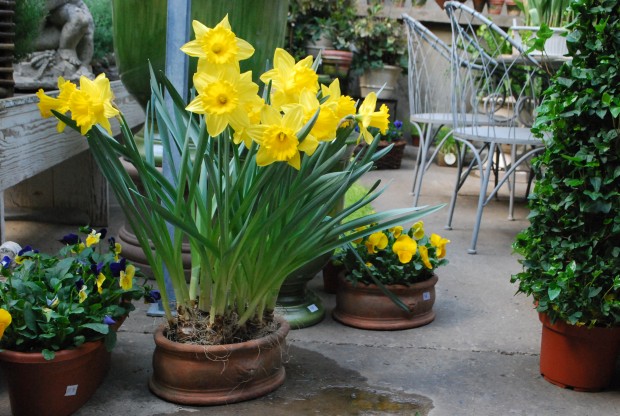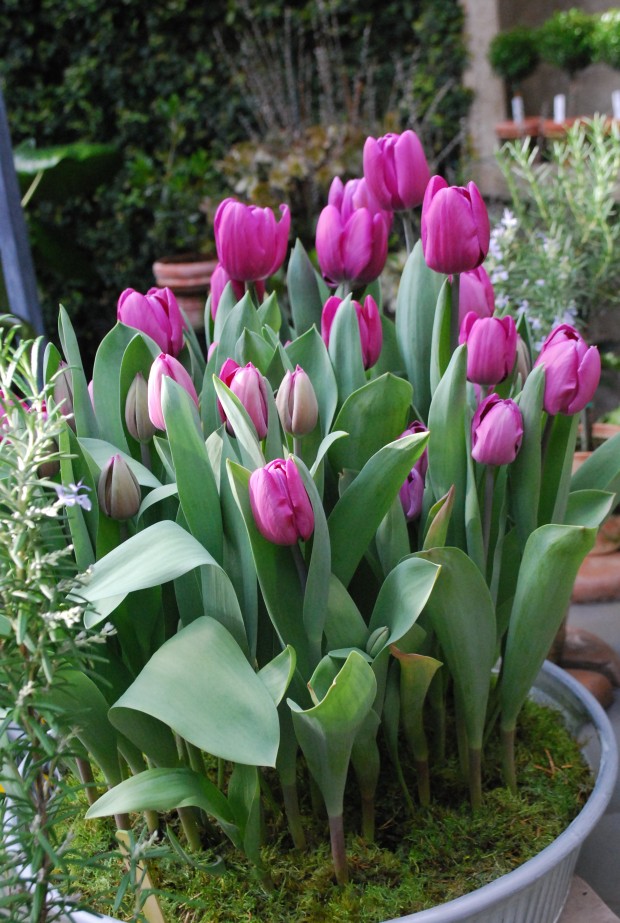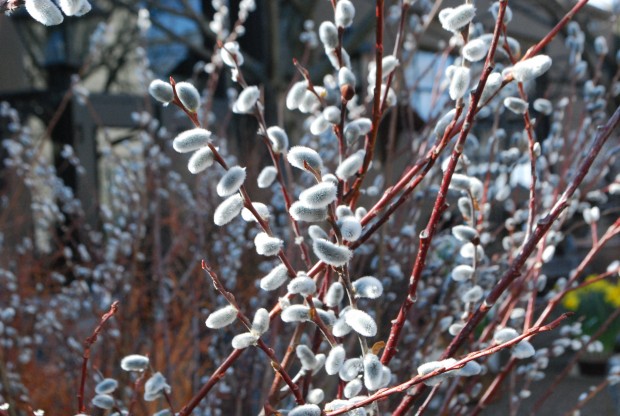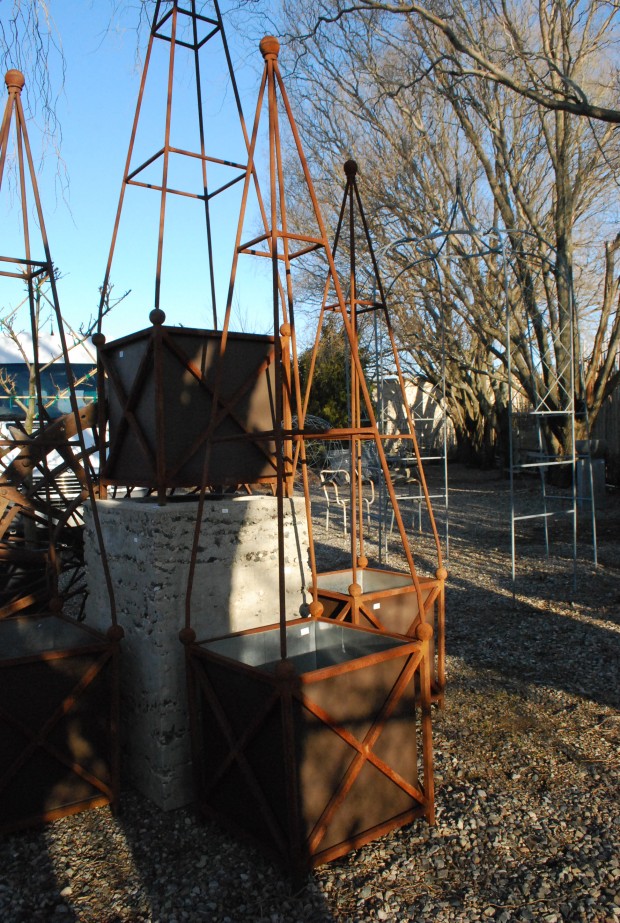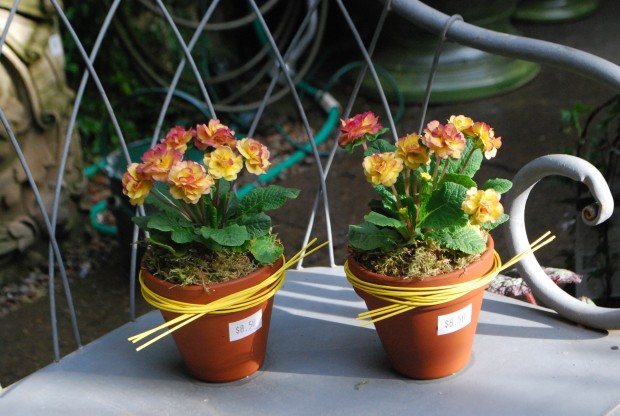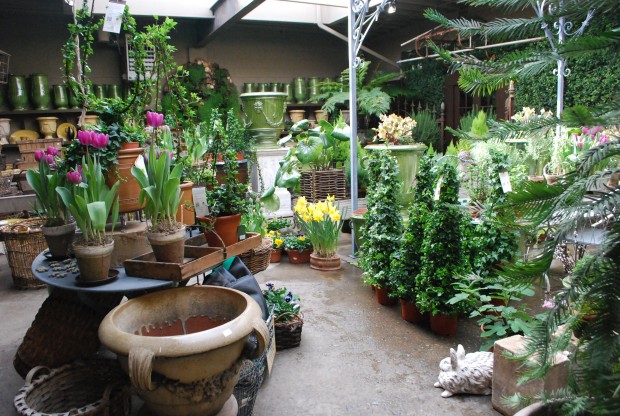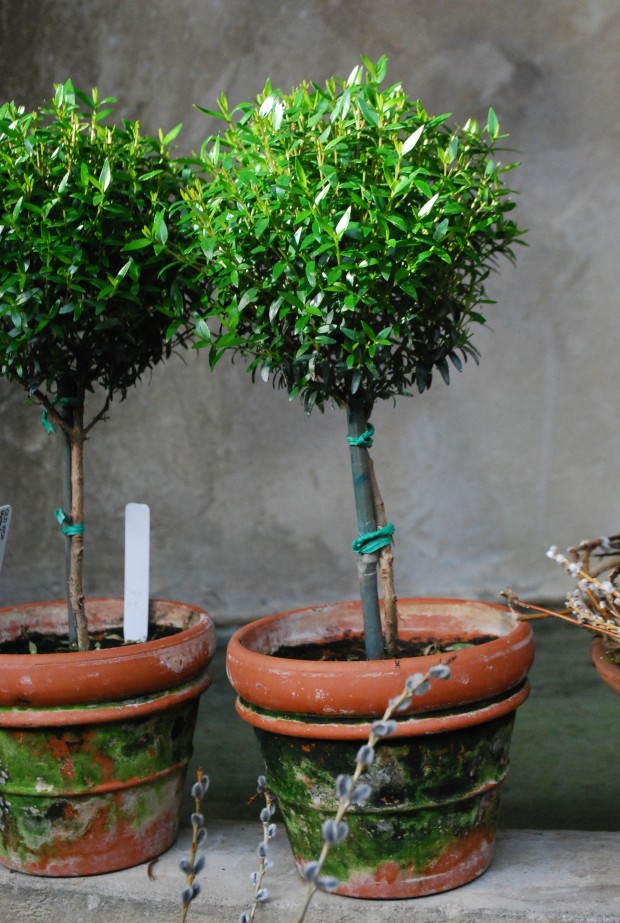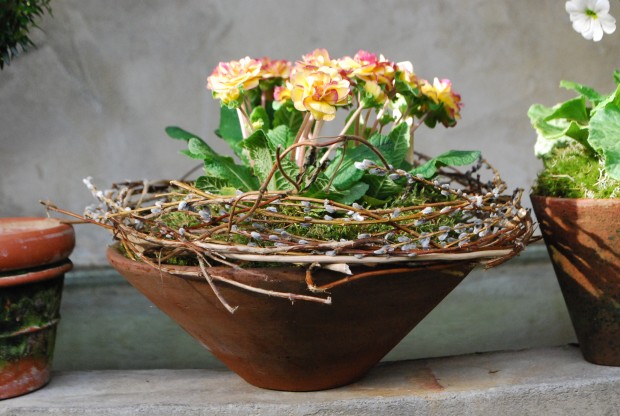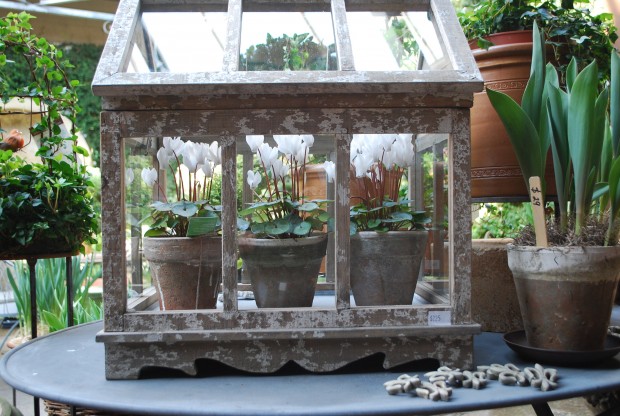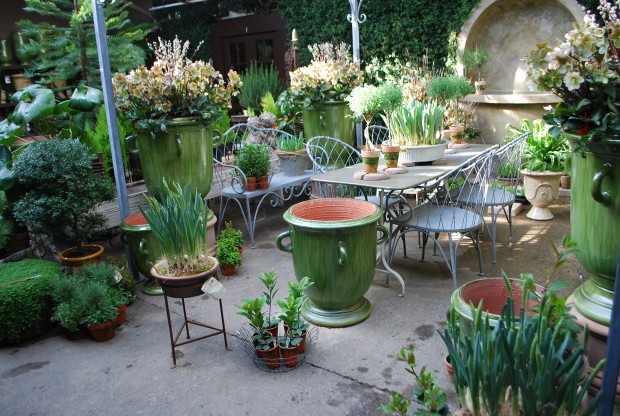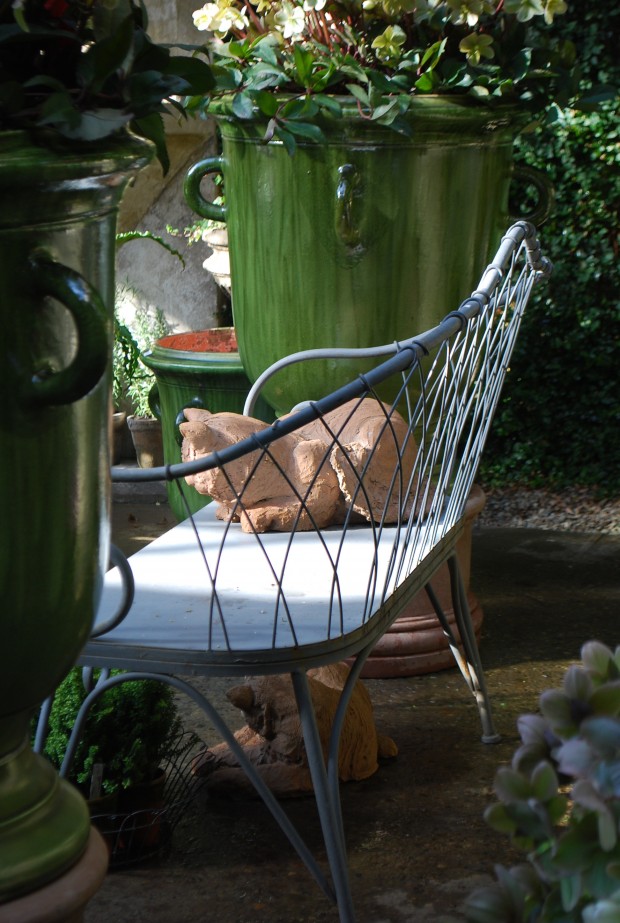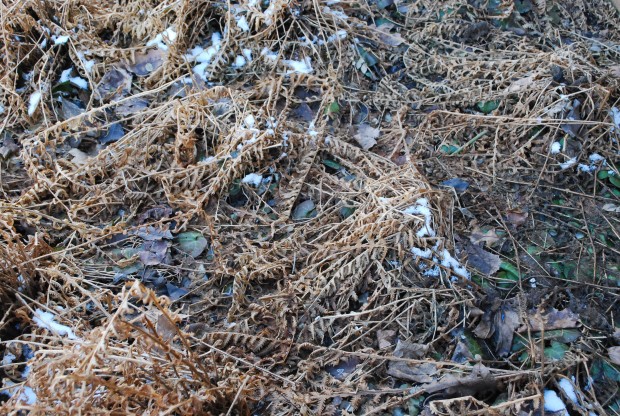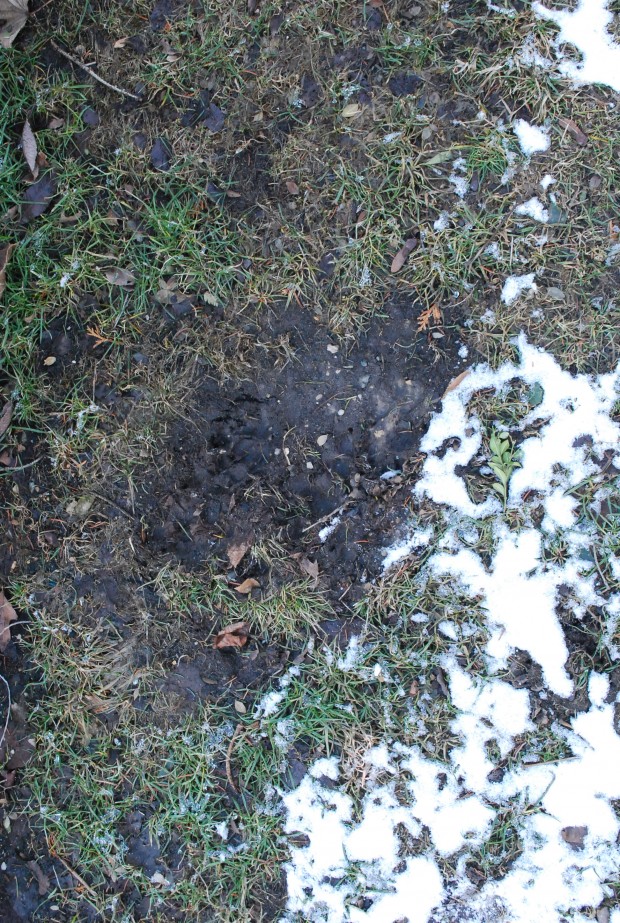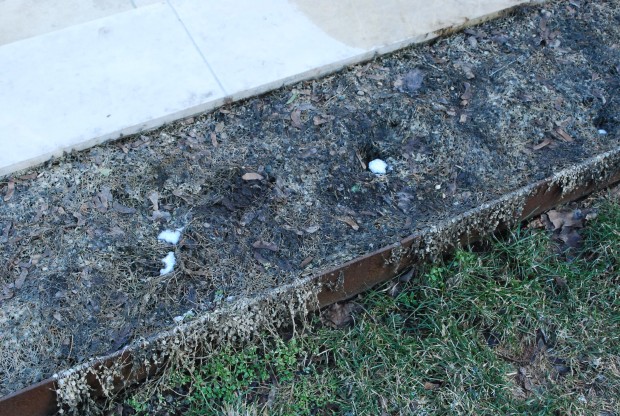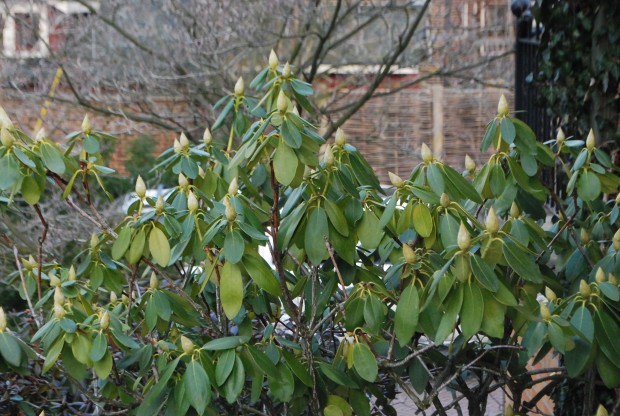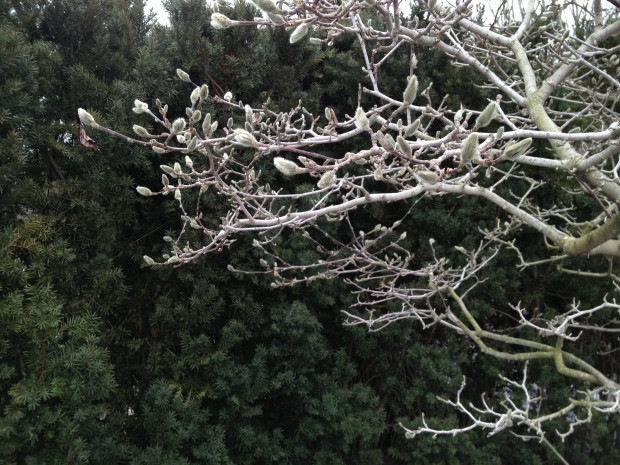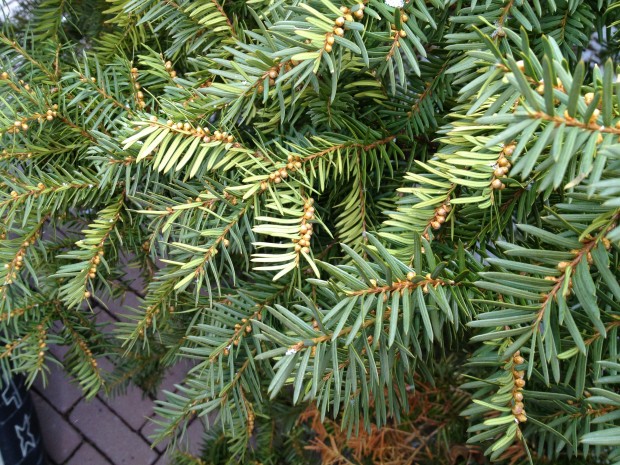At A Glance: Easter Sunday
Holed Up
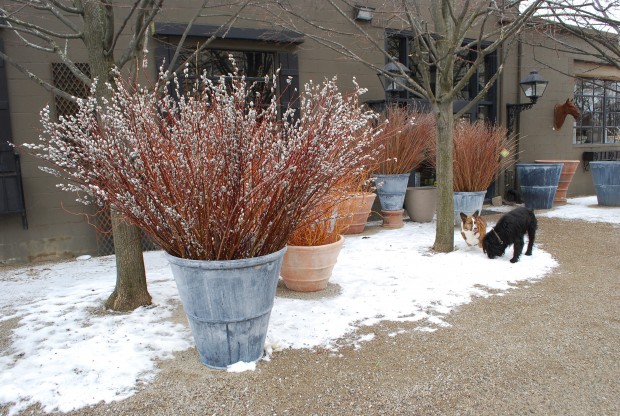
I expected to feel exasperated-but this scene made me laugh. The cut pussy willows are representing for all the world as if it were spring. At their feet, the remnants of hard packed snow and frozen ground tell a different story. Though it is late March, our weather is quite February-like. This is the late winter hand we have been dealt. We have not been able to do so much outside the shop, as everything is frozen to the ground. Some espaliers breaking bud when the arrived went in the garage. Other, unquestionably dormant, we placed outside-and we hope for the best.
 Prairie willow-I am confident it is tough as nails. It grows in the prairies-this means that weather extremes are the norm. I had no problem placing the bunches outdoors; they will shrug off the cold. But what would anyone do with them? Pots, and the soil in them, are still frozen solid. A vase full of prairie willow inside-that would not only be beautiful, it’s just about all we can do. The prairie willow may be fine outside given night temperatures in the teens, but we are holed up, pending a shift of the season. Plants and animals have great mechanisms for dealing with untoward weather. The bears hibernate. The bats congregate deep in caves. The plants go dormant, and stay that way. Lichens go dull in color when dormant. A heavy rain brings them roaring back to an interactive life. Some pine cone seeds will not germinate, unless there is a fire. Other seeds will not germinate unless they have a cold period, or a good soaking. The perennials die back to the ground. They endure the winter, their life on hold- underground.
Prairie willow-I am confident it is tough as nails. It grows in the prairies-this means that weather extremes are the norm. I had no problem placing the bunches outdoors; they will shrug off the cold. But what would anyone do with them? Pots, and the soil in them, are still frozen solid. A vase full of prairie willow inside-that would not only be beautiful, it’s just about all we can do. The prairie willow may be fine outside given night temperatures in the teens, but we are holed up, pending a shift of the season. Plants and animals have great mechanisms for dealing with untoward weather. The bears hibernate. The bats congregate deep in caves. The plants go dormant, and stay that way. Lichens go dull in color when dormant. A heavy rain brings them roaring back to an interactive life. Some pine cone seeds will not germinate, unless there is a fire. Other seeds will not germinate unless they have a cold period, or a good soaking. The perennials die back to the ground. They endure the winter, their life on hold- underground.
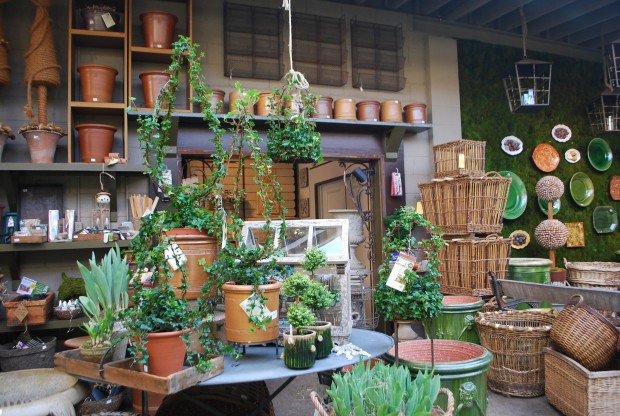
The first truly warm day of spring-insects hatch, and swarm. The grass puts on a green outfit. The bulbs, long silent underground, push up towards the sun. The process by which the natural world wakes up after a winter is an extraordinary event to witness. Who knows what day will signal sweet release from the dormant season. No doubt, every northern gardener is waiting. Given that people do not hibernate, they are witness to every moment of the winter.
I am a natural organism that does not go dormant. My winter life involves heat and shelter. This means I live through the winter, like it or not. I am not a skier or a snow shoe afficianado-I endure. My experience of the dormant season involves lots of winter gear-coat, boots, gloves, and hat. And the time it takes to get dressed. No doubt, I am a hothouse variety. In Victorian times, miniature greenhouses known as Wardian cases would protect tropical plants from any hint of cold. Rob’s placement of these cyclamen in a Wardian case-his dry and subtle humor at work. Cyclamen cleave to the cold. No need to heat them up. What really needs a place in this Wardian case-all of us gardeners living in northern climates.
The late winter weather aside, we have plants. Potted bulbs. Hellebores. Delivered just today, topiary plants, big and small. Bulb pans overflowing with angelina. Tiny euonymus topiaries. We have had to make a place for the plants under glass, and inside. We heat this space to 50 degrees. Any amount of sunshine will quickly warm it up. From now until the middle of May, this room will be stuffed with plants. The moment the winter weather breaks, every gardener will be looking for plants.
 The plants make the space smell great. The hyacinths blooming fill the entire space with their fragrance. Rob washes down the floor almost every day. The resulting humidity is a welcome break from the dry winter air.
The plants make the space smell great. The hyacinths blooming fill the entire space with their fragrance. Rob washes down the floor almost every day. The resulting humidity is a welcome break from the dry winter air.
Even this stoneware cat has an aura opf contentment, given a sunny spot on a bench.
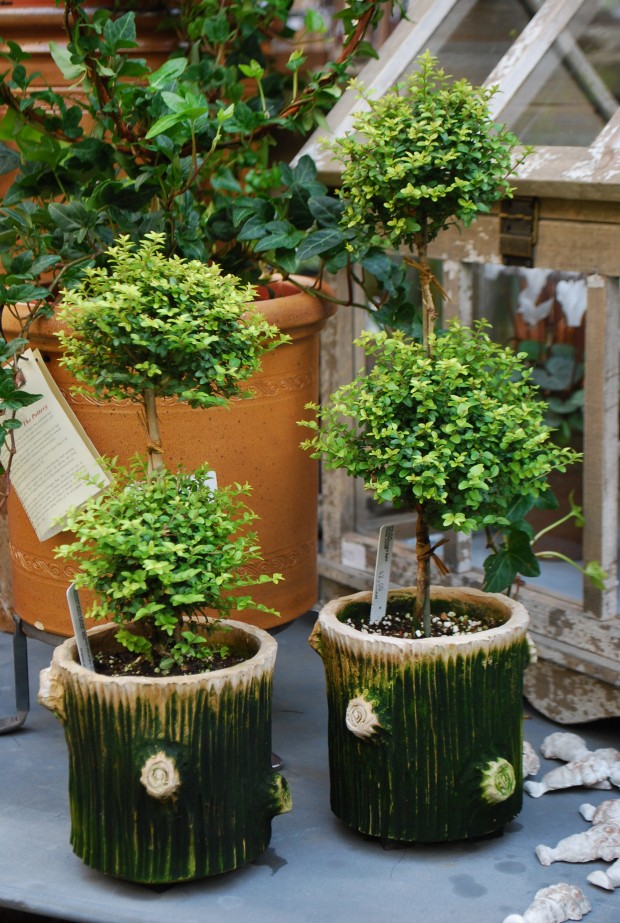
These double ball boxwood-leaved honeysuckle topiaries are charming in their stump pots. The moss on the surface tells the story. These plants have been grown with heat, water, and some shade.
 Euonymus trained into a topiary standard is a great plant for a small space. It is the most luscious shade of green imaginable.
Euonymus trained into a topiary standard is a great plant for a small space. It is the most luscious shade of green imaginable.
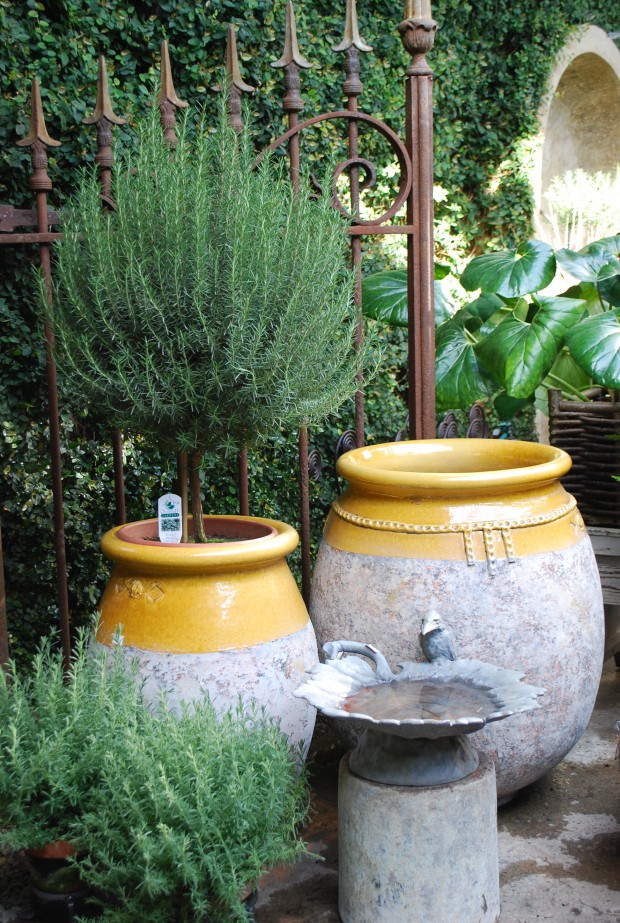 Rosemary on standard, and tubs of lavender have that warm Mediterranean look-not to mention the fragrance.
Rosemary on standard, and tubs of lavender have that warm Mediterranean look-not to mention the fragrance.
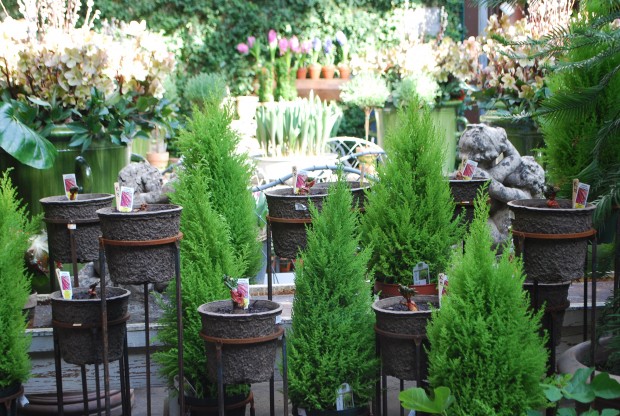 Rob starts rhubarb in pots early-they make such great centerpieces in spring pots. The large leaves atop red stalks-you can’t miss them. Nothing could be further in color and texture from rhubarb than a lemon cypress. This lime foliaged version of an Italian cypress is not hardy in our zone, though it will tolerate fairly low temperatures. They also look great in spring containers. Plants wintered in a space that stays above freezing grow fast.
Rob starts rhubarb in pots early-they make such great centerpieces in spring pots. The large leaves atop red stalks-you can’t miss them. Nothing could be further in color and texture from rhubarb than a lemon cypress. This lime foliaged version of an Italian cypress is not hardy in our zone, though it will tolerate fairly low temperatures. They also look great in spring containers. Plants wintered in a space that stays above freezing grow fast.
 Ivy topiaries are great for shady locations outdoors, and they are fairly easy to winter indoors. The vines grow fast if they are happy. Regular snipping to hold the shape is one of those garden chores that is actually a pleasure. How Rob has paired them will simple terra cotta cylinders is handsome.
Ivy topiaries are great for shady locations outdoors, and they are fairly easy to winter indoors. The vines grow fast if they are happy. Regular snipping to hold the shape is one of those garden chores that is actually a pleasure. How Rob has paired them will simple terra cotta cylinders is handsome.
 The shop has a few other places that get good light, and a fair amount of sun on a sunny day. Forced bulbs are good for low light spots indoors. They come already programmed to bloom. If the light is too low, the green of the foliage will fade, and the leaves will stretch and flop over. It’s only natural that plants seek the light-it is essential to their well being.
The shop has a few other places that get good light, and a fair amount of sun on a sunny day. Forced bulbs are good for low light spots indoors. They come already programmed to bloom. If the light is too low, the green of the foliage will fade, and the leaves will stretch and flop over. It’s only natural that plants seek the light-it is essential to their well being.
 Even low light tolerant plants will struggle if that low light goes on for too long. We rotate our plants in and out of low light areas, in a effort to keep them happy. Plants placed in the dark too long look as grumpy as gardeners who are stuck indoors.
Even low light tolerant plants will struggle if that low light goes on for too long. We rotate our plants in and out of low light areas, in a effort to keep them happy. Plants placed in the dark too long look as grumpy as gardeners who are stuck indoors.
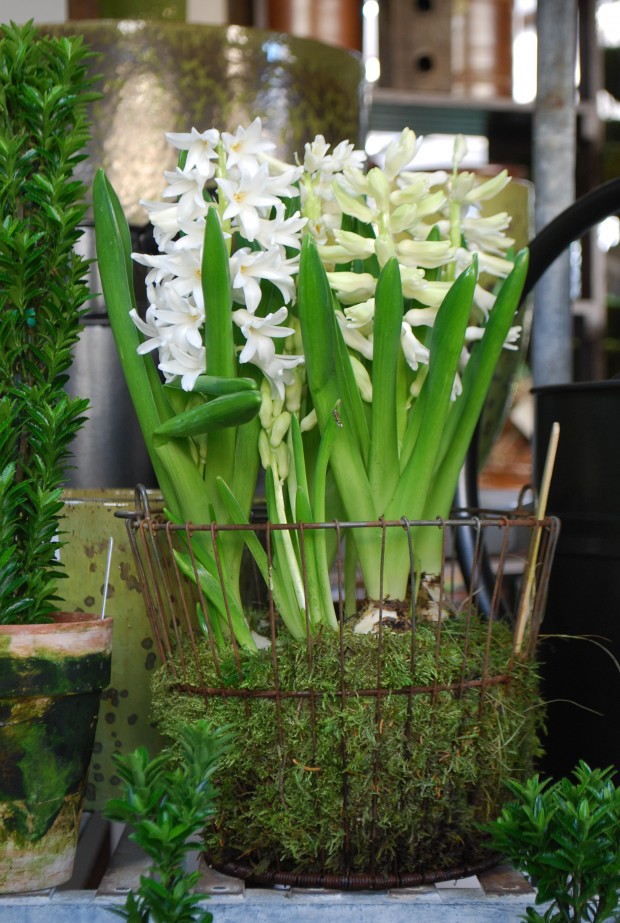 Hyacinths forced in pots provide a lot of late winter pleasure. The leaves are good looking. The buds are good looking. The flowers will last quite a while, provided they have a well lit spot that is not too hot. Potting them low in a container provides a little support for the big leaves and large flowering stalks.
Hyacinths forced in pots provide a lot of late winter pleasure. The leaves are good looking. The buds are good looking. The flowers will last quite a while, provided they have a well lit spot that is not too hot. Potting them low in a container provides a little support for the big leaves and large flowering stalks.
 Spring plants indoors-a way to make the best of the worst of it.
Spring plants indoors-a way to make the best of the worst of it.
Budded
If you garden, March is an acutely disappointing month. If March feels like an illness to you, it is. That late winter gardener’s fever–entirely predictable. The hope that spring is almost here when it is in fact many weeks away-a normal symptom of said illness. Once March arrives, no matter what constitutes likely and reasonable, I am over the winter. I have eyes, ears and a nose for spring. Though I have written this in countless ways for the last month, this time I really mean it! The thought that spring is near has been much on my mind- for weeks. What the gardening heart hopes for bears no remote resemblance to reality-that conflict would be a good definition of a Michigan March. Hope versus reality-game on.
My yard is a trashed by the winter.The grass is the color of hay. That hay has been pounded into the ground by the corgis, so the color is actually dirty hay. How many gallons of paint do you suppose a paint manufacturer might sell if they names a color dirty hay? Well, ok, gardeners might warm up to it. But the idea of dirty hay is pretty unappetizing. Just like March in Michigan.
The isotoma around my fountain at home looks dead. The leaves are brown and black, accented by a glaze of rot. Who knows if or how much of it has survived this winter. Some of the coldest days of the winter are courtesy of this March. How it looks right now-horrifying. The clematis are but brittle sticks, and the boxwood are burned. My moss stuffed cow-known as Lady Miss Bunny, has dead weeds sticking out of her side. Dead rotting leaves are sprinkled all over the yard. Could my garden possibly look worse than it does right now?
The European ginger? The leaves are limp, and lay flat on the ground-exhausted. I so understand this feeling. The look of it-I try not to look. Many of the leaves have those large black patches gardeners know as decomposition. I do not dare clean them up yet-we have night forecasts in the 20’s for the next week. Most of the snow was gone, meaning really cold night temperatures could hurt.
My hopes for March are always unrealistic. Last year’s March was warm-enticing. Though it satisfied my need for an early spring, it made me uneasy. April confirmed that unease. Freezing temperatures over an extended period of April days was destructive to early spring flowering trees, maples, and birch. No spring for us, last year. The 2012 spring disaster- every gardener in my zone remembers. The nights covering vulnerable plants to no avail. All of the hellebores blooming collapsed in pathetic heaps on the ground. Such shock-realizing that our spring would be erased by deadly low temperatures. Gardeners far away wrote to me, their voices charged with grief and irritation very much like mine. Gardeners in my zone and in many other regions have been waiting for a glorious spring for close to 2 years.
March is anything but a spring month; March is in fact the last of the winter season. We have has snow more days these first 2 weeks of March, than not. A single oddball 62 degree day made me believe the winter was over-I truly believed that the crocus, eranthis and hellebores were but days away. But one day does not a spring season make. The utter cold has returned; just this morning, four inches of fresh snow. I m shoveling, not gardening. March is a month marked by the tumultuous transition from one season to another. Sometimes that transition is easy and sensible. Other times that transition is so slow, boring, and treacherous, one could weep.
The trees and shrubs have no such angst. They go dormant given the day length and temperatures. They set buds for spring season, months ahead. They prepare. They have no expectation of mercy. They wait. The urge to emerge revolves around a complex set of conditions. Natural relationships that culminate in the OK to grow.
A bud is an undeveloped shoot. A leaf or a flower shoot. Once formed, that bud may lay dormant for months, waiting for the moment when conditions favor growth. When woody plants form buds, the exterior of that bud is tough-encapsulating. Breaking dormancy is a very vulnerable state-best not to do so, unless there is a reasonable expectation of success. Nature provides mechanisms by which that tender stage we call growth is protected from its enemies, until the time is right. Many plant buds are covered in scales. These modified leaves protect the life brewing within that bud from cold, wind,and physical insult.
Many buds are covered in a gummy substance that further protects them from untoward conditions. These magnolia flower buds have a remarkably rigid hinged casing that is covered in soft downy hair. This magnolia is always the first plant to bloom in my yard. The buds are swelling, meaning that spring will arrive. Everywhere in my zone the buds are beginning to swell. They anticipate spring in a very different way than I do. They intuit the natural shift of the season. They respond to that subtle change in conditions, in a slow and subtle way. These buds may swell, but they won’t break dormancy until there is a more extended period of moderate weather.
The buds can hold a very long time, if the weather does not take a more friendly turn. Most perennials have naked buds. What you see in this picture is the remains of my asparagus. The spring shoots are still safely ensconced below ground. They have little defense against bitter cold. They stay dormant, buds and all, until they have the all clear. The leaf buds of the roses, encased in the same waxy substance as the stems. They are ready, but holding their cards close.
The cream colored knobs on this yew-the flowers that will hardly be noticed. The flowering stage is remarkable, the day a gust of wind throws a cloud of yellow pollen into the air. At the tip of each branch, an elongated bud known as a candle. Named for its resemblance to a candle, this growth tip is comprised of the countless needles which will populate the new shoots. These needles lay flat against the stem, until the spring weather encourages them to spread out and grow. The buds do a better job of predicting the arrival of spring than my winter weary heart.
Monday Opinion: What Time Is It?
Daylight savings time means that Sunday March 10th was a day with only 23 hours. One would think that anything planned for the day could easily be accomplished in 23 hours instead of 24, but you decide. Howard showed up bedside at 5am like he always does, but it really was 6 am. He and Milo usually have breakfast at 6, but 6 had already come and gone. By 7, which was now 8, I was late for work, and the corgis still had not had breakfast. If you are confused, you know exactly how I felt (or am I still feeling it?). I usually have lunch at 11:30, which, but the new 11:30 is actually 10:30. So Sunday brunch. By this time I had at least remembered to feed the corgis. I was half way to a landscape appointment until I realized I would be an hour early. In looking at my watch, I see that the second hand is only moving every 20 seconds or so. What? I circle back, and spent 40 minutes sitting in my office trying to figure it out. Why really do we spring ahead, and then fall back? I knowing children walking to the bus stop has something to do with it. The other reasons seem unconvincing and arbitrary. Now there will be more time after work to stand in the garden and be able to do nothing. I will have more evening daylight to contemplate the frozen ground. I still have mountains of snow, even though it was 62 degrees yesterday. I am a day late expressing the opinion that a day with only 23 hours felt like a day that was out of reach from start to finish. Today I was late for work, and cranky.
The days are getting longer. Who knows exactly what day the sun will finally make up that lost hour. At least it will be months before that 25 hour day arrives in November. In the meantime, that out of sorts feeling can be diminished by just one thing. The sure signs of spring. It was just a few days ago that I heard birds singing when I woke up. The magnolia stellata, even though it is heavily mulched with snow, looks like the buds are ready to burst. Yesterday it was 62 degrees. Today it is pouring rain. It is muddy and icy, everywhere. Milo’s footprints all over the shop make it look like we have not mopped for months. What he doesn’t deposit on the shop floor is now in my office. These are sure signs of spring. The watch I have had for years is not running right. It will take 10 days to send it out for evaluation. However, I am sure I already know what is wrong. Even my watch can’t figure out what time it is.
